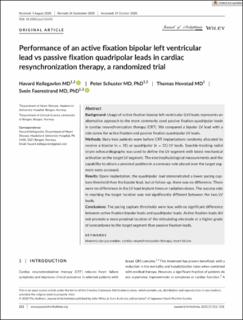| dc.contributor.author | Keilegavlen, Håvard | |
| dc.contributor.author | Schuster, Peter | |
| dc.contributor.author | Hovstad, Thomas | |
| dc.contributor.author | Færestrand, Svein | |
| dc.date.accessioned | 2021-08-09T10:47:35Z | |
| dc.date.available | 2021-08-09T10:47:35Z | |
| dc.date.created | 2020-12-04T10:14:52Z | |
| dc.date.issued | 2021 | |
| dc.identifier.issn | 1880-4276 | |
| dc.identifier.uri | https://hdl.handle.net/11250/2766980 | |
| dc.description.abstract | Background
Usage of active fixation bipolar left ventricular (LV) leads represents an alternative approach to the more commonly used passive fixation quadripolar leads in cardiac resynchronization therapy (CRT). We compared a bipolar LV lead with a side screw for active fixation and passive fixation quadripolar LV leads.
Methods
Sixty-two patients were before CRT implantations randomly allocated to receive a bipolar (n = 31) or quadripolar (n = 31) LV leads. Speckle-tracking radial strain echocardiography was used to define the LV segment with latest mechanical activation as the target LV segment. The electrophysiological measurements and the capability to obtain a proximal position in a coronary vein placed over the target segment were assessed.
Results
Upon implantation, the quadripolar lead demonstrated a lower pacing capture threshold than the bipolar lead, but at follow-up, there was no difference. There were no differences in the LV lead implant times or radiation doses. The success rate in reaching the target location was not significantly different between the two LV leads.
Conclusions
The pacing capture thresholds were low, with no significant difference between active fixation bipolar leads and quadripolar leads. Active fixation leads did not promote a more proximal location of the stimulating electrode or a higher grade of concordance to the target segment than passive fixation leads. | en_US |
| dc.language.iso | eng | en_US |
| dc.publisher | Wiley | en_US |
| dc.rights | Navngivelse 4.0 Internasjonal | * |
| dc.rights.uri | http://creativecommons.org/licenses/by/4.0/deed.no | * |
| dc.title | Performance of an active fixation bipolar left ventricular lead vs passive fixation quadripolar leads in cardiac resynchronization therapy, a randomized trial | en_US |
| dc.type | Journal article | en_US |
| dc.type | Peer reviewed | en_US |
| dc.description.version | publishedVersion | en_US |
| dc.rights.holder | Copyright 2020 The Authors. | en_US |
| cristin.ispublished | true | |
| cristin.fulltext | original | |
| cristin.qualitycode | 1 | |
| dc.identifier.doi | 10.1002/joa3.12450 | |
| dc.identifier.cristin | 1856135 | |
| dc.source.journal | Journal of Arrhythmia | en_US |
| dc.source.pagenumber | 212-218 | en_US |
| dc.identifier.citation | Journal of Arrhythmia. 2021, 37 (1), 212-218. | en_US |
| dc.source.volume | 37 | en_US |
| dc.source.issue | 1 | en_US |

